When the autumn comes my friends’ social media accounts scream with mushroom picking photos. Mushroom foraging is sort of a family’s hobby in a lot of Eastern European countries. In my family it was a popular thing too. So, when I moved to Portugal, I wanted to continue with the family tradition.
Only I didn’t realise that the talk about mushroom picking would get Portuguese people rolling their eyes. It would seem they were thinking what is this crazy one talking about? Apparently, almost every year there are some people here dying from poisonous mushrooms that they pick and eat.
It’s not that mushroom poisoning doesn’t happen in Lithuania, sometimes it happens. But, frankly, you should worry more about getting tick-borne encephalitis in Lithuanian forests while foraging for mushrooms, as it happens much more often than mushroom poisoning. Portugal is awesome for mushroom picking and nature adventures because there is very little possibility of getting a thick-born disease in forests and the encephalitis it entails, which can be deadly.
When is the best time to pick mushrooms?
While the harvest of various fruits, etc. comes sooner in Portugal than in northern European countries, the most quantity of mushrooms we find is mid October to mid November. While, for example, in Lithuania the end of August or beginning of September is mushrooms’ prime time.
But, for example, the yellow chanterelles once in 10 years I found in Portugal in July. Unfortunately, never again. Actually, we found one, lonely chanterelle this autumn, in the mid of October. It was strange because chanterelles are the “earliest” mushrooms, it’s much more expectable to find them in July or August than in October. Secondly, chanterelles usually grow in groups and finding just the one was strange.
In some Portuguese articles it’s said that you can pick mushrooms all year in Portugal. For chanterelle they say it mostly grows in October and springtime.
We pick mushrooms in the north of Portugal, in the region of Minho around Paredes de Coura, Vila Nova de Cerveira. Northeastern Trás-os-Montes region is also a good option for mushroom picking and the region of Ribatejo used to have tradition of mushroom foraging.
What kind of mushrooms do we find?
Every year we find a lot from the “suillus” genus like slippery jacks or bolete bovines (“suillus bovinus”). Birch boletes are also found often. In my family and in general these mushrooms are not rated very highly. They are ok but it doesn’t put a big smile on your face if you find them.
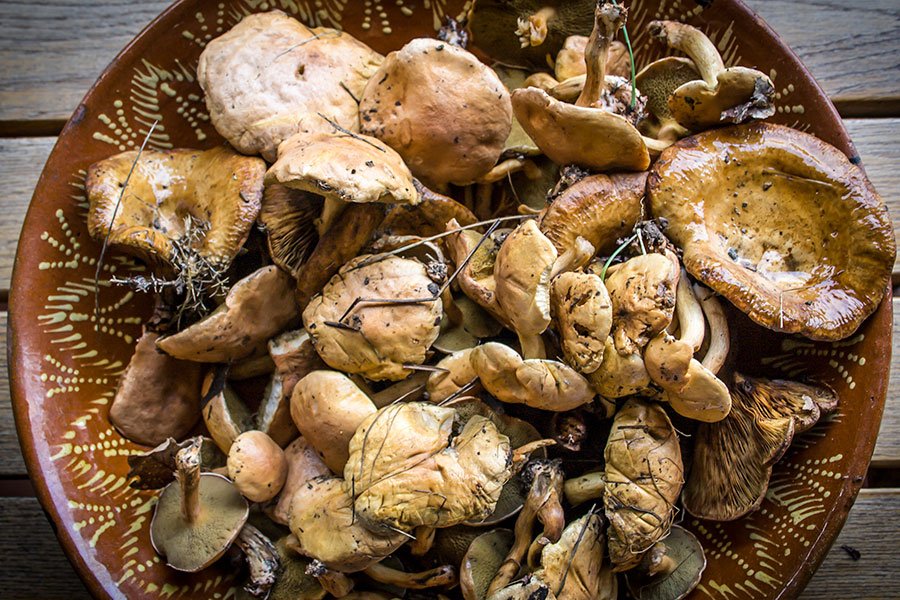
This October we found quite a lot of chestnut boletes (“gyroporus castaneus”) and it put a big smile on our faces. Even bigger smiles were on our faces when we found penny buns (“boletus edulis”) or porcini and white king boletes (“boletus barrowsii”). The last two are considered to be “kings” of mushrooms, they are very highly rated.
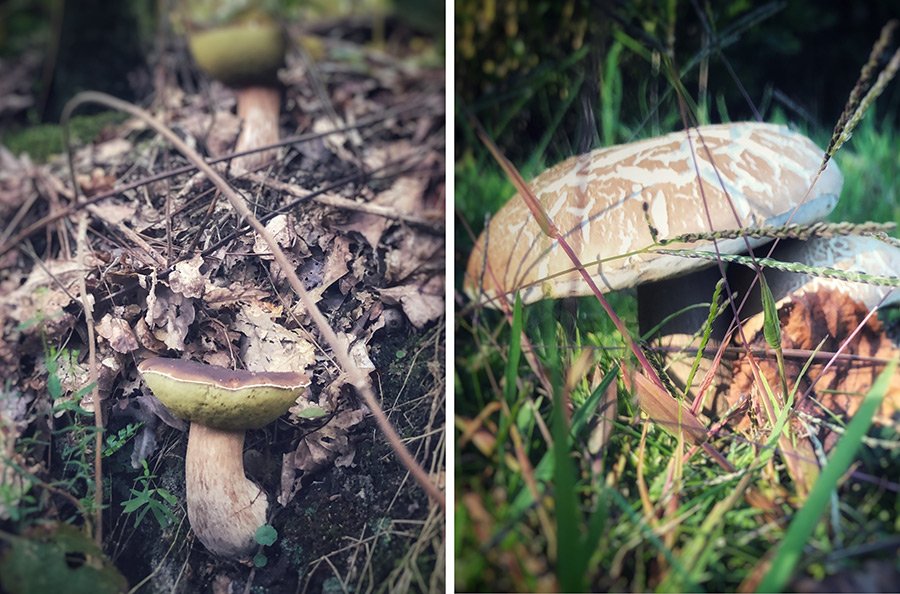
Besides a few, already mentioned chanterelles, we also would find saffron milk caps (“lactarius deliciosus”), always a lot of brittlegills (“russula”). But the last ones we pick if we don’t find any other mushrooms. They are not highly valued mushrooms.
This year we started to pick parasol mushrooms (“macrolepiota procera”) after I heard how good it tastes and verified several times. It was a mushroom growing literally under our windows in our village.
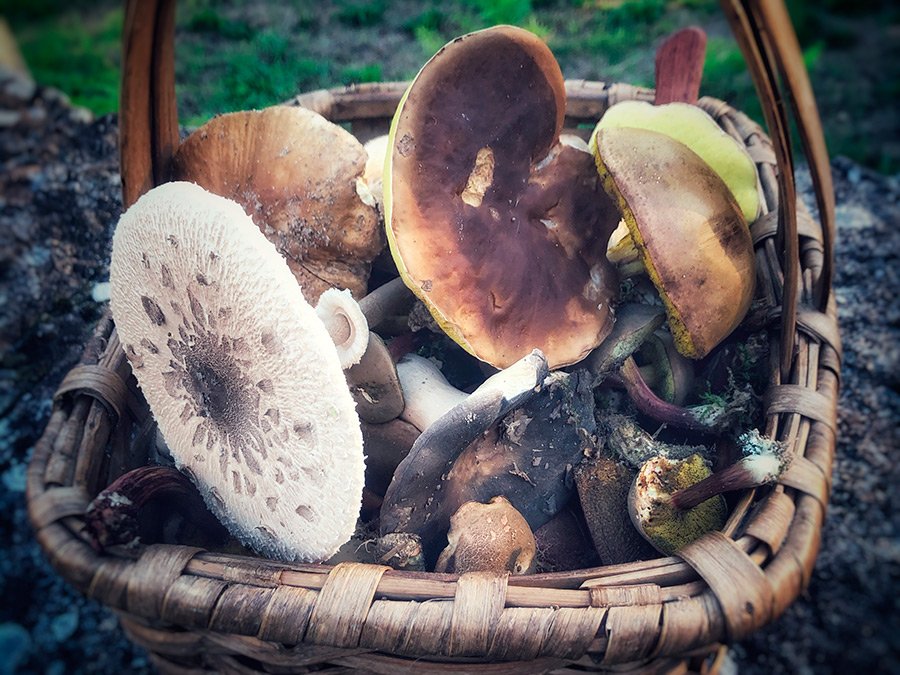
How to prepare mushrooms?
It’s important to prepare mushrooms correctly so that you don’t have digestion problems. You should know that mushrooms are supposed to be a heavy meal for your digestive system. However, I really like to eat mushrooms and never ever had any digestion problems.
After we pick mushrooms, we gently remove dirt from them, separate stem from caps, and cut in slices both parts. “Wooden”, older stems we throw out. Very often you can notice the worm-eaten parts of a mushroom. We cut out these parts and throw out as well as very old mushrooms that are good but contain too many toxins.
The sliced mushrooms are put into a bowl of water and rinsed. There are some chefs and other cooking experts who are against rinsing mushrooms’ with water or even cutting them to see if they are damaged by worms. Frankly, I prefer thorough cleaning rather than keeping a mushroom intact. And I don’t feel that rinsing with water affects the taste, they’re still very tasty for me.
After cleaning, we boil the mushrooms for about 10-15 minutes. It’s purpose is getting rid of toxins. And you can see that the water turns dark after boiling mushrooms. We take it away and then the mushrooms are good to go into a pan with melted butter. We fry them while stirring, add some salt, parsley or other herbs, if we have. If we don’t have any herbs, we go well without them. Several times we added some Port wine, it worked perfectly! Follow these tips and you’ll have a tasty starter dish.
In the case of chanterelles and saffron milk caps (“lactarius deliciosus”) you don’t need to boil them, you can fry them directly. Also, they aren’t usually eaten by worms. In the case of the parasol mushrooms (“macrolepiota procera”), you also don’t boil them. The stem you throw out, you cut in pieces the big cap, envolve them in whisked eggs and then into flour before deep frying them. It’s very tasty!
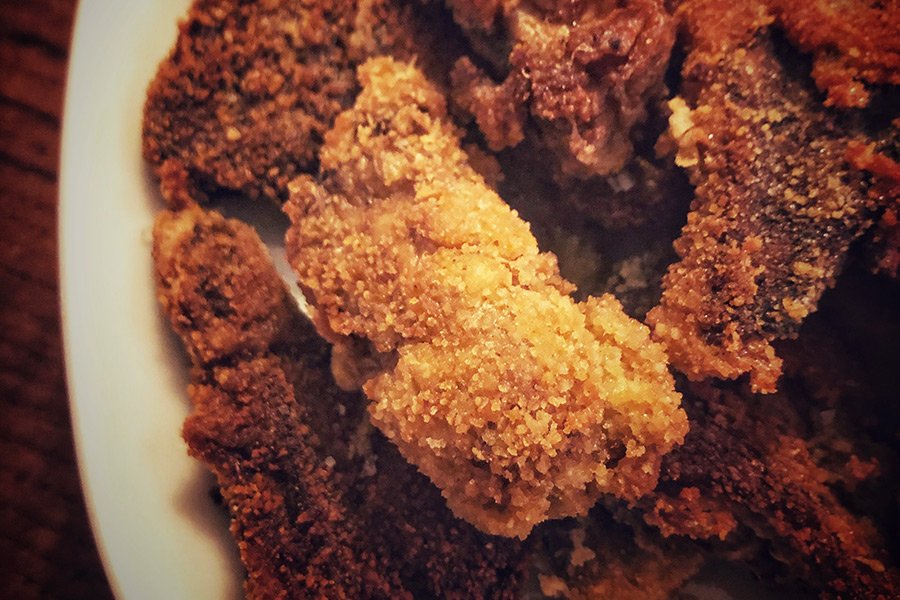
Final thoughts about mushrooms
In the previous chapter I wrote quite a lot about toxins in mushrooms. You may have started to think “why the hell eat them”?!
Well, mushrooms are low in calories and fat, they’re cholesterol-free, contain some amount of fiber and many minerals and vitamins including copper, potassium, zinc, magnesium, a number of B vitamins. Besides, well prepared mushrooms are delicious!
In Lithuania mushrooms are often pickled and then used in various dishes during Christmas, with herring, etc. I love dumplings with dried mushrooms. My goal is to dry them here in Portugal. The only problem is that usually here we do not find big amounts of mushrooms, secondly, you need firm mushrooms, like boletes, to dry. Not every mushroom is good for drying.
Last but not least, I love picking mushrooms as well as eating them! To the beginner mushroom forager, I would suggest going with someone who knows mushrooms during your first times. Like Pedro would go with me 🙂
Secondly, don’t pick what you don’t know or you are not sure about. Not all good looking mushrooms are edible.
On a final note, have you ever thought that mushroom picking can be the best form of mindfulness?

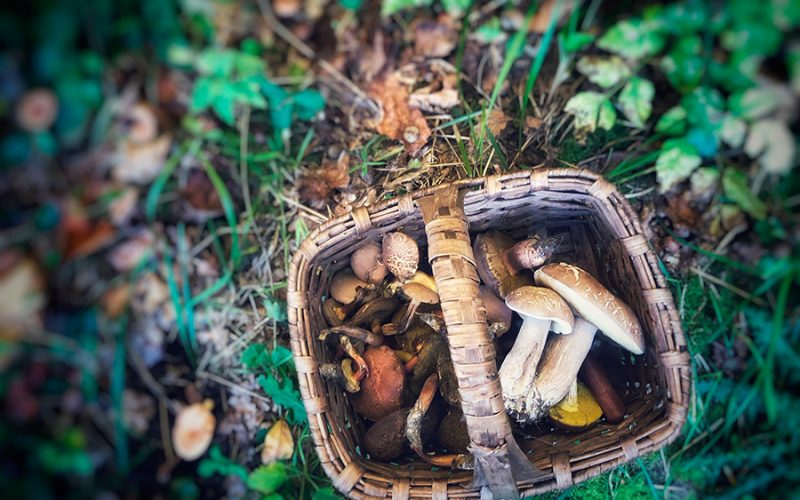
Hi Lina, wow such a great article, do you know if amanitas grow in spring. Also I have a beautiful cottage in a meadow close to Podence, if you are ever in this area please let me know, there are tons of mushrooms here 🙂
Hello Mario, thank you for nice words and sorry for replying only now! It’s good to know that there are a lot of mushrooms around Podence! Regarding the amanitas, you mean, amanitas caesareas, I assume: I have never found one, or to be more precise – I never looked for it 🙂 I know, it’s a very valuable mushroom and has visible distinctions from poisonous amanitas but it was never in my radar, so to speak. I don’t know much about them.
I am looking for a private class to learn about Moshroom in Arabida park
Would you be able to guide me ?
Thank you
🙏🏼
Sorry Therese, I only today realised that was something wrong with the comments on the blog! Unfortunately, I also don’t know anything about the topic… 🙁
we have a lot of large , about 10 cm across , white mushrooms growing under our hawthorn hedges , in clumps. are these edible. look like the mushrooms you would buy in a shop
Hello Lina.
Could you recommend any spots with mushrooms around Porto?
Thank you in advance.
Hello Artur,
I really don’t know any spots around Porto, sorry!
I just picked some mushrooms at the Douro Valley! Near Cinfaes at this hiking trail
Nice! What kind of mushrooms did you find?
Hi. We are a couple from Ukraine. We used to hunt for mushrooms a lot, and know the species. But now in Lisbon, we have no idea where are the forests that are good for porcini. We have a car, so a distance up to 100 km is ok for us. Any recommendations on directions and woods to try? Or maybe some contacts whom we can talk with? Thank you very much.
Hello Denys, maybe try to contact EcoFungos (https://www.facebook.com/Ecofungos/), it’s a mycological association that acts more in the areas of Área Metropolitana de Lisboa, Grândola, Golegã etc. From this article (https://www.wilder.pt/historias/trabalhando-com-a-vida-selvagem-conheca-a-ecofungos-e-como-esta-a-ajudar-os-cogumelos/) – it’s in Portuguese but with Google Translator you can translate it to English – it talks about mycological tours they organize, so they must know the forests in that area.
I hope it helps, cause personally I don´t know the forests more in the South of Porto. Also, mushroom hunting here for me, at least, has never been as in Lithuania when you come back full of baskets with mushrooms ☺
Sintra national park.
What I really need to know is: what kind of mushroom is this and is it edible. You seem to have left that part out. A comprehensive list of all available wild mushrooms in Portugal with pictures of the tops and undersides with a measuring stick to indicate size, what kind of biome they were found in, are they poisonous, not poisonous but not very good to eat, or good to eat, and where they are typically located in the wilderness. If you can provide that, then you might live up to the title of your page.
Thanks for the feedback.
Mushroom picking is a dangerous activity that should be done only by people with thorough training. Our practice usually ends with an identification of the least known mushrooms when back at home.
As to this article, it is just intended to be an appetiser to what you can find and expect if you decide to partake in this activity in Portugal.
The point here is that even if we would have produced the kind of information you list, this would not be enough for a safe identification of mushrooms. Field guides are very concise and even these have much more information such as smell/odour, colour of the flesh, presence of soft or hard “ring”, colour of the spores, etc.
Plus, the edible species available vary from region to region and depending on the season of the year.
If you are interested in experiencing this in Portugal or need more help identifying mushrooms, let us know and we can try to point you to the books we use or to the websites or groups of experts where we seek further help when needed.
Thank you! ☺
Hi! Thanks for this excellent article!
This will be definitely something to do when my mother in law comes to see us later this year!
However, can you tell me which area of Ribatejo is more likely to find mushrooms? I’m from Lisbon and I don’t know the region. Is Sintra also a good place for mushrooms? Thanks!
Hi, it’s nice you found the article useful! Frankly, we explored more the areas in Minho for mushrooms. But in Instagram @cotafilipeofficial constantly puts the the photos of mushrooms from around the areas of Lisbon. So he might know more about mushroom picking in Ribatejo.
Actually, this post would need some update. Because I was complaining about not finding chanterelles but this year it was the first year we found them several times in groups as they grow. Surprisingly it was the end of November and the beginning of December.
Thank you! Such an excellent article. I would love to discover the region you are talking about. I am Swedish living in France and having a house in portugal close to the ocean. (Fig.da foz)
I find Cantrell around here in the forest mainly around December and January. After the devastating fires it is hard to find any. Would love to pick mushrooms in the mountains.
Thanks, happy you enjoyed the post.
As I said to Paulo, we don’t have much experience around Figueira da Foz.
We have explored Minho (mainly around Vila Nova de Cerveira, Paredes de Coura and Caminha) and Trás-os-montes (Bragança). But mushrooms are very time sensitive. They can grow in around a week or two and completely vanish for a while. You are likely to find them from May to October after a period of rain followed by warm weather.
When do you usually visit? Are there any pine tree forests in your area?